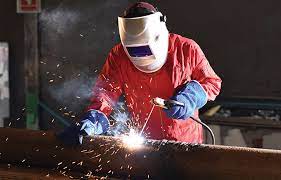Welding Fume Health EFFECTS
Welding Fume Extractor – Welding
Welding metals containing cadmium, chromium, lead, manganese, and nickel poses health risks to anyone who breathes the air when these fumes are present. The Environmental Protection Agency (EPA) has new requirements to reduce air pollution from compounds of these such metals.
Welding Fume

.https://www.apzem.in/index.php/product-category/fume-extractor/welding
These compounds are emitted into the air from various operations at metal fabrication, finishing plants. Exposure to the different types of welding fumes may result in different health effects. If a welder inhales gases, fumes and Vapors in large quantities over long periods, this may have a negative effect on his health.
Welding Gases
Vapors or fumes can come from coating and residues on metal being welded. Some ingredients in coatings can have toxic effect. These ingredients include: metalworking fluids, oils, and rust preventatives.
Zinc on galvanized steel (vaporizes, releasing zinc oxide fumes) Cadmium plating Chromate shielding gases such as carbon dioxide, argon, helium, etc. fuel gases such as acetylene, propane, butane, etc. oxygen used with fuel gases and also in small amounts of some shielding gas mixtures.
Welding Fume Effects
- Irritation of the welding tract Metal fume fever Sideris chronic inflammation of the lungs An increased risk of lung cancer Some of the components of welding fume, such as oxides of chromium, nickel, cadmium, and manganese are known as suspected carcinoma.
- A stainless steel welding fume has a higher content of these alloying elements like (as well as carbon) than mild steel welding fume does the former was thought to be significantly more hazardous. What the IARC discovered in that while mild steel welding fume contains much lower concentrations of these elements the concentrations is still potent enough to cause cancer in humans.
- The nose typically filters and collects much to the smoke, fumes, and grinding dust welding machines create. But some welding fume particles is very small in size and can pass through the nose, the sinus cavity, down the throat, and into the lungs.
- Most people never even notice an irritation. After a years of inhaling welding fumes, you begin to exhibit signs. Cause The most plausible theory involves an immune reaction that occurs when inhaled metal oxide fumes injure to cells lining the airways.
- This is thought to modify proteins in the lung. The modified proteins is then absorbed into the bloodstream, where they act as a allergens. It is usually associated with inhaling zinc fumes, although some believe that copper and magnesium can also cause the problem.
- Welding joins materials together by melting of a metal work piece along with a filler. Metal to form the strong joint. The welding process produces visible smoke that It contains harmful metal fumes and gas by-products. This fact sheet discusses about welding. operations, applicable OSHA standards, and suggestions for protecting welders and Coworkers are protected from exposure to the many hazardous substances in welding fume.
- Gases and fine particles in welding fume can cause dryness of the throat, coughing or tightness in the chest. This effects tend to be short-lived.
Welding Fume Extractor
Welding fumes are combination of various metals. For instance, mild steels are mostly iron, but it also contains a manganese, which has received a great deal of attention recently in terms of its effect on health. Stainless steels are also contains iron, as well as nickel and chromium. Simple steps can minimize exposure. Use any provided ventilation system (Welding Fume Extractor). Don’t stand in front of the air flow pushing fumes away from your workspace. Position your face as far from the fumes as possible. Use an small cooling fan if no air flow moves fumes from your workspace. https://www.apzem.in


